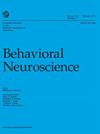外侧哈文脑在条件性抑制和抑郁中的新作用
IF 1.5
4区 医学
Q3 BEHAVIORAL SCIENCES
引用次数: 0
摘要
将中性的条件刺激(CS)与不存在的具有生物学意义的非条件刺激(US)联系起来,会赋予 CS 条件性抑制特性,即条件性抑制。条件抑制和条件刺激(CS 与 US 存在的关联)是联想学习的基本组成部分。条件性兴奋的神经基质已被充分确定,但条件性抑制的神经基质仍鲜为人知。最近的研究揭示了外侧兔脑(LHb)与中脑多巴胺能神经元在条件性抑制中的参与。本文回顾了为评估条件性抑制而进行的行为任务,以及实验性 LHb 操作如何影响这些任务的表现。这些结果强调了 LHb 在条件性抑制中的关键作用。耐人寻味的是,压力会增加LHb的反应性,并损害动物在包含条件性抑制成分的任务中的表现。抑郁症患者也会出现 LHb 功能障碍。生物体进行条件性抑制的能力与 LHb 神经元活动的改变密切相关,这对精神疾病有一定的影响。(PsycInfo Database Record (c) 2024 APA, 版权所有)。本文章由计算机程序翻译,如有差异,请以英文原文为准。
Emerging role of the lateral habenula in conditioned inhibition and depression.
Associating a neutral conditioned stimulus (CS) with the absence of a biologically significant unconditioned stimulus (US) confers conditioned inhibitory properties upon the CS, referred to as conditioned inhibition. Conditioned inhibition and conditioned excitation, an association of a CS with the presence of the US, are fundamental components of associative learning. While the neural substrates of conditioned excitation are well established, those of conditioned inhibition remain poorly understood. Recent research has shed light on the lateral habenula (LHb) engagement in conditioned inhibition, along with the midbrain dopaminergic neurons. This article reviews behavioral tasks conducted to assess conditioned inhibition and how experimental LHb manipulations affect performance in these tasks. These results underscore the critical role of the LHb in conditioned inhibition. Intriguingly, stress increases LHb reactivity and impairs performances in tasks consisting of a component of conditioned inhibition in animals. Dysfunction of the LHb is observed in patients with depression. The ability of an organism to perform conditioned inhibition is closely linked to altered neuronal activity in the LHb, which has implications for mental disorders. (PsycInfo Database Record (c) 2024 APA, all rights reserved).
求助全文
通过发布文献求助,成功后即可免费获取论文全文。
去求助
来源期刊

Behavioral neuroscience
医学-行为科学
CiteScore
3.40
自引率
0.00%
发文量
51
审稿时长
6-12 weeks
期刊介绍:
Behavioral Neuroscience publishes original research articles as well as reviews in the broad field of the neural bases of behavior.
 求助内容:
求助内容: 应助结果提醒方式:
应助结果提醒方式:


